Public Health and Infectious Disease
This tutorial will introduce basic epidemiological concepts related to infectious disease and how GIS can be used in public health to analyze and communicate surveillance information about infectious disease.
Infectious Disease
Infectious diseases are illnesses caused by microorganisms, such as bacteria, viruses, parasites or fungi, that invade the human body (WHO 2020a). Many (but not all) infectious diseases are also communicable in that they can be spread directly or indirectly from one person to another (Correll 2019). Infectious diseases are a perennial source of misery and death for all living organisms, but public health interventions can mitigate the effects of infectious diseases.
The microorganisms that cause infectious diseases are called agents. Infectious diseases are transmitted when an agent leaves a reservoir through a portal of exit, is conveyed by a mode of transmission, and enters a portal of entry to infect a susceptible host (CDC 2020, 1:10).
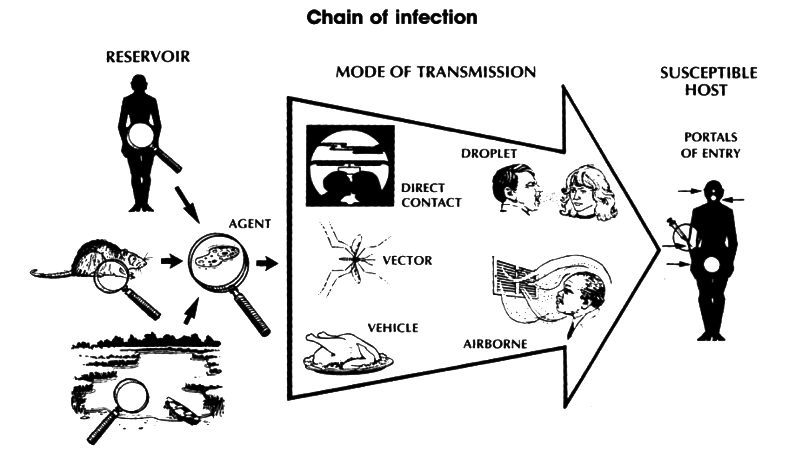
Epidemiology is "the study of the distribution and determinants of health-related states or events in specified populations, and the application of this study to the control of health problems" (Last 2001, 61; CDC 2012, 1:1).
The epidemiological approach analyzes diseases in a three step process (CDC 2012, 1:5):
- Count: Tally the cases or health events along with descriptions of times, places, and people.
- Divide: Divide the number of cases by a denominator (usually population) to calculate disease rates.
- Compare: Compare rates across different times, locations, and/or groups of people to identify changes, patterns, and relationships.
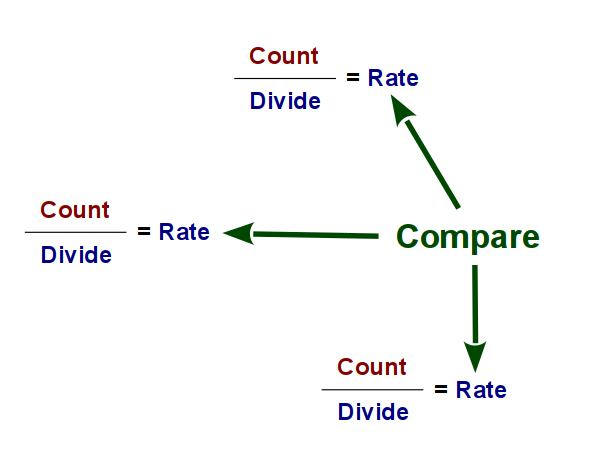
Disease Statistics
Incidence, Prevalence, and Mortality
There are three disease rates commonly used in epidemiology, based on what is being counted (Coggon, Rose, and Barker 2020):
- Incidence: The number of new diagnoses or occurrences (cases) of a health condition
- Prevalence: The number of people who have a health condition
- Mortality: The number of people who die from a health condition
Counts vs Rates
Data about diseases is collected as counts of new cases (incidence), existing cases (prevalence), or deaths (mortality). However, disease statistics are often expressed as rates calculated as the counts divided by the number of people living in the areas where the disease is being counted.
Rates for common disease are expressed as percents (per 100 people), while uncommon diseases are often expressed as rates per 100,000 people in order to keep from having to use very small numbers. For example, 30 cases per 100,000 residents is easier to read and compare than 0.03%.
Because older residents tend to have higher rates of disease than younger residents, rates are often age-adjusted to compensate for areas that have large numbers of older or younger residents. This allows clearer identification of areas where diseases are more common rather than just areas where there are more senior residents.
Rates are often more useful than counts when comparing different areas with different sized populations, or the same areas at different times when the population changes over time. While areas with larger populations will generally have higher counts of a disease, a small area with a higher rate (but lower count) of disease may be of special interest to public health official trying to identify areas where health problems are emerging or are most severe.
Counts are more useful than rates for proportionately distributing resources. For example, health clinics can service more people if they are located in areas that have the highest counts of conditions handled by those clinics. Locating a health clinic in a remote area with an unusually high rate of disease but a very small population may not (depending on the situation) be the most effective use of resources.
In the examples below, the map of tuberculosis counts is largely a map of the most populous states, while the map of cancer rates shows that tuberculosis is especially high in a handful of states.
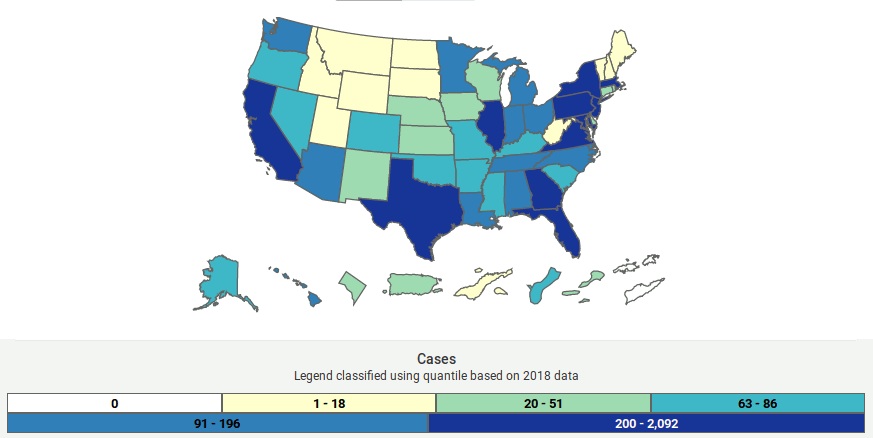

Levels of Prevalence
The ordinary prevalence of a disease in a community is called the endemic level of a disease. Some diseases (such as rabies) that occur infrequently are referred to as sporadic. Other diseases that persist at high levels (such as human papillomavirus) are referred to as hyperendemic (CDC 2020, 1:11).
There are a variety of terms for situations where rates of disease rise above the normal endemic level (CDC 2020, 1:11):
- Cluster: A clumping of cases in a particular place and time where the endemic level is not known
- Epidemic: An increase in the number of cases in an area above the normal endemic level
- Outbreak: An epidemic confined to a limited geographic area
- Pandemic: An epidemic that has spread over multiple countries and/or continents, and which affects a large number of people
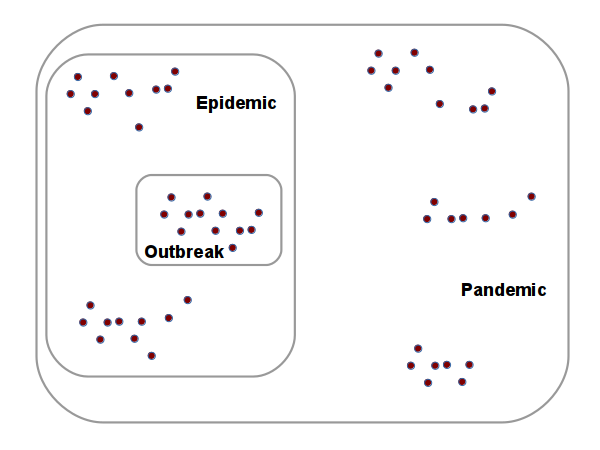
Disease Severity
Different disease agents affect the human body in different ways, and, likewise, move through human populations in different ways. Many of these characteristics can be rated or quantified to better understand how infectious diseases spread, and how those transmissions can be slowed or stopped.
How Many People Does It Kill: Case Fatality Rate
The deadliness of a disease is often expressed in terms of the case fatality rate (CFR), which is the percent of people diagnosed with a disease that eventually die from the effects attributable to that disease.
Higher CFR values are more severe. For example, the CDC (2015) lists the CFR for chickenpox as between 0.001% and 0.003% (meaning it is rarely fatal), while Tauenberger, Reid, and Fanning (2000) estimated the CFR for the deadly 1918 influenza pandemic was around 2.5%.
Although some diseases are generally more deadly than others, a CFR is specific to a particular time and place, and is not fixed for any particular disease agent. A CFR can be lowered by improved treatments and access to quality clinical care (CDC 2020 3:3).
Case fatality rates are also subject to variability due to issues with reporting. The number of reported cases will be different from the number of people who actually have the disease when some people go undiagnosed because their symptoms are mild or they do not have access to clinical care. And although fatalities are usually tracked fairly closely by public health officials, deaths attributable to a disease may be reported as caused by underlying or related conditions (such as pneumonia) that cannot be unambiguously tied to the disease in question (CDC 2020 3:3).
Note that CFR differs from mortality rates that are expressed as the proportion of deaths relative to the total population.
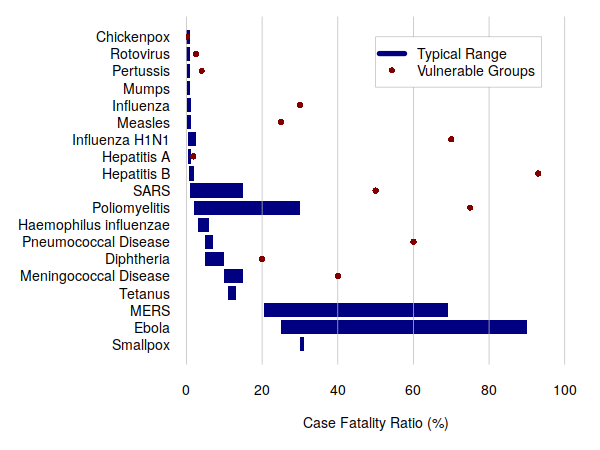
(click here for detailed data and sources)
How Readily Does It Spread: The Basic Reproduction Number R0
The basic reproduction number R0 is an estimate of how contagious a disease is in terms of the average number of people that will catch the disease from one infected person (Ramirez 2016).
Diseases with higher R0 values spread more quickly than diseases with lower R0 values unless there is some kind of intervention. For example, Cobern, Wagner, and Blower (2009) estimated the R0 for the 1918 global influenza pandemic at between 1.4 and 2.8. In contrast, Bacaër et al. (2006) found the R0 for HIV/AIDS among IV drug users in Kunming, China was 32.
The basic reproduction number (R0) only applies when no interventions are in effect to control the spread of a disease. As natural immunity, vaccinations, and other control measures are implemented, the effective reproduction number (R) can usually be driven down below one, which means the disease will eventually stop spreading and remain at a low level or disappear from the population (Chiew et al. 2013).
Delamater et al. (2019) notes that R0 values are affected by numerous biological, socio-behavioral, and environmental factors, and should not be misinterpreted as fixed properties of pathogens in all places and times. Li and Blakeley (2011) go even further to assert that "in almost every aspect that matters, R0 is flawed."
The following chart shows R0 estimates for a variety of infectious diseases:
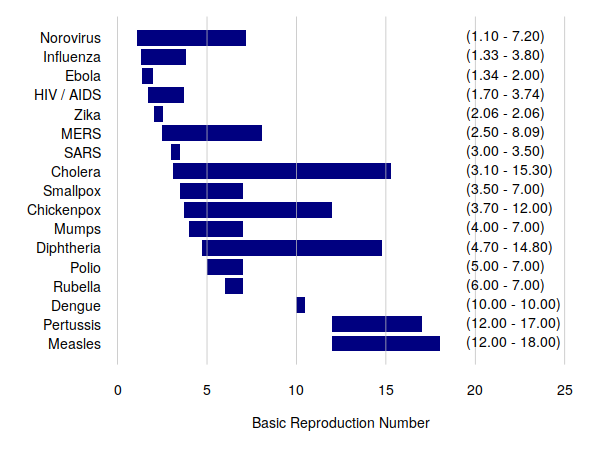
(click here for detailed data and sources)
Factors Affecting The Spread of Infectious Disease
- Protective Factors:
- Improved sanitation
- Public health agencies
- Responsive governance
- Immunization
- Personal hygiene
- Availability of clinical care
- Pathogenic sentiment (public awareness and anxiety)
- Risk Factors:
- Mobility
- Population density
- Warfare and political instability
- Interface with wildlife and livestock
Typical Public Health Interventions
- Proactive Interventions: Interventions to prevent outbreaks:
- Educational campaigns
- Immunization campaigns
- Needle and condom distribution
- Improvement of drinking water supplies
- Animal control measures to prevent zoonotic disease
- Reactive Interventions: Interventions in response to new or ongoing outbreaks:
- Health emergency declarations
- Quarantines
- Support for local providers
- Vaccine development
Infectious Disease Surveillance Maps
Surveillance has six common objectives with infectious diseases (WHO 2018):
- Monitor disease elimination or eradication efforts
- Detect outbreaks and new pathogens
- Provide evidence for new vaccine introduction or optimization of vaccine schedules
- Evaluate immunization program performance and define the need for supplementary immunization
- Evaluate vaccine effectiveness, impact on disease burden, or both
- Detect changes in disease strains or types
One highly-visible application of GIS in epidemiology is the dissemination of current infectious disease surveillance data on web maps. These maps can inform healthcare providers, researchers, and the general public about the current state of epidemics and pandemics. That information can then be used to inform public health responses to those situations.
Global Maps
HealthMap is a web
app created by a team of researchers, epidemiologists and software
developers at Boston Children's Hospital as an informal online source
for "disease outbreak monitoring and real-time surveillance of
emerging public health threats"
ProMED is a disease news monitoring service with new articles displayed on a web map The Program for Monitoring Emerging Diseases (ProMED) is a program of the International Society for Infectious Diseases (ISID) that was launched in 1994 to identify unusual health events related to emerging and re-emerging infectious diseases and toxins affecting humans, animals and plants (ISIC 2002).
The Metabiota Epidemic Tracker, a freely-accessible web app that provides current information on a number of specific pathogens. Metabiota is a private company that partners with businesses and governments worldwide to "identify and track pathogens from their source, then contextualize the risk based on socioeconomic, political, environmental and other factors" (Metabiota 2020).
For the COVID-19 pandemic in 2019-2020, Johns Hopkins University's Center for Systems Science and Engineering (CSSE) used the ArcGIS Online Dashboard to create a web app dedicated to sharing current information on worldwide infections and deaths.
One notable feature of this app was the ability to download the weekly data via GitHub. The video below shows how to download that data and create your own version of the map in ArcGIS Online. A CSV file of this data from 12 February 2020 can be downloaded here.
- Navigate through the GitHub directories to find the most recent report file.
- Download the Raw file to your hard drive.
- Create a new map in ArcGIS Online.
- Add -> Add Layer From File.
- Set the Addresses or Places Location Fields for the World so the app knows how to geocode the locations.
- Symbolize by the field of interest.
- Set transparency so overlapping bubbles are visible.
- Choose the desired base map.
- Show the legend.
- Save and share the map.
US National Maps
FluView is an interactive web map created as part of the weekly influenza surveillance report prepared by the Centers for Disease Control and Prevention's (CDC) Influenza Division. This map can be animated to show the spread of seasonal influenza over the year.
This data can also be downloaded for map creation or further analysis. The video below demonstrates how FLUVIEW data can be downloaded, joined to a state polygon layer, and mapped as a choropleth in ArcGIS Online.
- Navigate in the FluView map to the week of interest.
- Download Data and Data as Shown On Map and save the CSV file to your local hard drive
- Create a new map in ArcGIS Online
- Add -> Add Layer From File with the CSV file
- For Locations, choose Addresses and Places in the United States and select the state name column.
- Add the Living Atlas Layer USA States (Generalized).
- On the state layer, click the perform analysis icon and select Summarize Data -> Join Features.
- The Target Layer should be the states and the Join Layer should be the points from the CSV file
- Give the layer a meaningful name
- Run the analysis
- Symbolize the activity estimate categories using a sequence of colors that reflects increasing severity.
- Save and share the map.
US State Maps
While state and local health departments collect significant amounts of infectious disease data as part of their surveillance responsibilities, they rarely make current infectious disease information available as web maps or downloadable geospatial data.
However, there are portals that make historical data available. Emory University’s Rollins School of Public Health in partnership with Gilead Sciences, Inc. and the Center for AIDS Research at Emory University (CFAR) make recent data on HIV infections available through their AIDSVu web map, and recent information on Hepatitis B infections on their HepVu web map. Both HIV and HBV are spread through bodily fluids and have the same risk factors (unprotected sex and shared needles), so these conditions are commonly addressed together by public health officials (NIH 2019).
The AIDSVu map has a number of features for viewing and sharing information:
- Select a city from the "City" tab to view ZIP Code level information in a city.
- Roll over the ZIP Code polygons to see the names of the ZIP Codes and the infection rates.
- Click the "Service Providers" icon to show the locations of service providers.
- Click the "Export to IFrame" icon to get a link to share the current view of the map.
Reference List
Bacaër, Nicolas, Xamxinur Abdurahman, and Jianli Ye. 2006. "Modeling the HIV/AIDS epidemic among injecting drug users and sex workers in Kunming, China." Bulletin of Mathematical Biology 68 (3): 525-550.
Boston Children's Hospital. 2020. "About." Accessed 10 February 2020. http://www.diseasedaily.org/about.
Centers for Disease Control and Prevention (CDC). 1992. "Principles of Epidemiology, Second Edition." Atlanta, GA: U.S. Department of Health and Human Services. https://www.cdc.gov/csels/dsepd/ss1978/lesson1/section10.html.
Centers for Disease Control and Prevention (CDC). 2012. "Principles of Epidemiology in Public Health Practice, Third Edition: An Introduction to Applied Epidemiology and Biostatistics." Atlanta, GA: U.S. Department of Health and Human Services. https://www.cdc.gov/csels/dsepd/ss1978/index.html.
Chiew, May, Heather F Gidding, Aditi Dey, James Wood, Nicolee Martin, Stephanie Davis, and Peter McIntyre. 2013. "Estimating the measles effective reproduction number in Australia from routine notification data." Bulletin of the World Health Organization 92, 171-177. http://dx.doi.org/10.2471/BLT.13.125724.
Chowell, Gerardo, Hiroshi Nishiura, and Luis MA Bettencourt. 2007. "Comparative estimation of the reproduction number for pandemic influenza from daily case notification data." Journal of the Royal Society Interface 4 (12): 155-166.
Chowell, Gerardo, and Hiroshi Nishiura. 2008. "Quantifying the transmission potential of pandemic influenza." Physics of Life Reviews 5 (1): 50-77. https://www.sciencedirect.com/science/article/abs/pii/S1571064507000413?via%3Dihub.
Chowell, Gerardo, Nick W. Hengartner, Carlos Castillo-Chavez, Paul W. Fenimore, and Jim Michael Hyman. "The basic reproductive number of Ebola and the effects of public health measures: the cases of Congo and Uganda." Journal of theoretical biology 229, no. 1 (2004): 119-126. https://www.sciencedirect.com/science/article/abs/pii/S0022519304001092.
Coggon, D., Rose, Geoffrey, and Barker, DJP. 2020. "Epidemiology For the Uninitiated." London: British Medical Association. https://www.bmj.com/about-bmj/resources-readers/publications/epidemiology-uninitiated/.
Correll, Robyn. 2019. "Differences Between Communicable and Infectious Diseases." Accessed 10 February 2020. https://www.verywellhealth.com/the-difference-between-communicable-and-infectious-diseases-4151985.
Delamater, Paul L., Erica J. Street, Timothy F. Leslie, Y. Tony Yang, and Kathryn H. Jacobsen. 2019. "Complexity of the basic reproduction number (R0)." Emerging Infectious Diseases 25 (1): 1. https://www.ncbi.nlm.nih.gov/pmc/articles/PMC6302597/.
Fisman, David, Edwin Khoo, and Ashleigh Tuite. 2014. "Early epidemic dynamics of the West African 2014 Ebola outbreak: estimates derived with a simple two-parameter model." PLoS currents 6. http://currents.plos.org/outbreaks/article/obk-14-0036-early-epidemic-dynamics-of-the-west-african-2014-ebola-outbreak-estimates-derived-with-a-simple-two-parameter-model/.
Gani, Raymond, and Steve Leach. "Transmission potential of smallpox in contemporary populations." Nature 414, no. 6865 (2001): 748-751. https://www.nature.com/articles/414748a.
Li, Jing, and Daniel Blakeley. 2011. "The failure of R0." Computational and mathematical methods in medicine 2011. https://www.hindawi.com/journals/cmmm/2011/527610/.
Hartley, David M., J. Glenn Morris Jr, and David L. Smith. 2005. "Hyperinfectivity: a critical element in the ability of V. cholerae to cause epidemics?." PLoS Med 3 (1): e7. https://journals.plos.org/plosmedicine/article?id=10.1371/journal.pmed.0030007.
Heininger, Ulrich. 2012. "Pertussis: what the pediatric infectious disease specialist should know." The Pediatric infectious disease journal 31, no. 1 (2012): 78-79. https://journals.lww.com/pidj/Fulltext/2012/01000/Pertussis__What_the_Pediatric_Infectious_Disease.21.aspx.
International Society for Infectious Diseases. 2002. "About ProMED." Accessed 10 February 2020. https://promedmail.org/about-promed/.
Last, John M., editor. 2001. "Dictionary of Epidemiology. Fourth Edition." New York: Oxford University Press; 2001. p. 61.
Metabiota. 2020. "Home." Accessed 10 February 2020. https://metabiota.com.
National Center for HIV/AIDS, Viral Hepatitis, STD, and TB Prevention (NCHHSTP). 2020. "AtlasPlus." Accessed 22 February 2020 https://www.cdc.gov/NCHHSTP/atlas/.
National Institutes of Health (NIH). 2019. "HIV and Opportunistic Infections, Coinfections, and Conditions." Accessed 9 February 2020. https://aidsinfo.nih.gov/understanding-hiv-aids/fact-sheets/26/89/hiv-and-hepatitis-b.
Nishiura, Hiroshi. 2006. "Mathematical and statistical analyses of the spread of Dengue." https://apps.who.int/iris/bitstream/handle/10665/170261/db2006v30p51.pdf.
Nishiura, Hiroshi. 2010. "Correcting the actual reproduction number: a simple method to estimate R0 from early epidemic growth data." International journal of environmental research and public health 7, no. 1 (2010): 291-302. https://www.mdpi.com/1660-4601/7/1/291.
Ramirez, Vanessa Bates. 2016. "What Is R0?: Gauging Contagious Infections." Accessed 10 February 2020. https://www.healthline.com/health/r-nought-reproduction-number.
World Health Organization (WHO). 2020a. "Infectious diseases." Accessed 10 February 2020. https://www.who.int/topics/infectious_diseases/en/.
Data References
Althaus, Christian L. 2014. "Estimating the reproduction number of Ebola virus (EBOV) during the 2014 outbreak in West Africa." PLoS currents 6.
Anderson, Roy M., B. Anderson, and Robert M. May. 1992. "Infectious diseases of humans: Dynamics and control." Oxford University Press.
Centers for Disease Control and Prevention. 2015. "Epidemiology and Prevention of Vaccine-Preventable Diseases, 13th Edition." https://www.cdc.gov/vaccines/pubs/pinkbook/.
Centers for Disease Control and Prevention. 2016. "Smallpox." https://www.cdc.gov/smallpox/clinicians/clinical-disease.html.
Centers for Disease Control and Prevention. 2015. "Middle East Respiratory Syndrome (MERS)." Accessed 16 February 2020. https://www.cdc.gov/coronavirus/mers/clinical-features.html.
Chowell, G., C. E. Ammon, N. W. Hengartner, and J. M. Hyman. 2006. "Estimation of the reproductive number of the Spanish flu epidemic in Geneva, Switzerland." Vaccine 24 (44-46): 6747-6750.
Coburn, Brian J., Bradley G. Wagner, and Sally Blower. 2009. "Modeling influenza epidemics and pandemics: insights into the future of swine flu (H1N1)." BMC medicine 7, no. 1 (2009): 30. https://www.ncbi.nlm.nih.gov/pubmed/19545404.
Fine, Paul E. M. 1993. "Herd Immunity: History, Theory, Practice." Epidemiologic Reviews 15 (2): 265–302. https://doi.org/10.1093/oxfordjournals.epirev.a036121.
Fraser, Christophe, Christl A. Donnelly, Simon Cauchemez, William P. Hanage, Maria D. Van Kerkhove, T. Déirdre Hollingsworth, Jamie Griffin et al. "Pandemic potential of a strain of influenza A (H1N1): early findings." science 324, no. 5934 (2009): 1557-1561. https://science.sciencemag.org/content/324/5934/1557.
Gao, Daozhou, Yijun Lou, Daihai He, Travis C. Porco, Yang Kuang, Gerardo Chowell, and Shigui Ruan. 2016. "Prevention and control of Zika as a mosquito-borne and sexually transmitted disease: a mathematical modeling analysis." Scientific Reports 6: 28070.
Gaythorpe, K. A. M., Caroline Louise Trotter, B. Lopman, M. Steele, and A. J. K. Conlan. 2018. "Norovirus transmission dynamics: a modelling review." Epidemiology & Infection 146 (2): 147-158.
Guerra, Fiona M., Shelly Bolotin, Gillian Lim, Jane Heffernan, Shelley L. Deeks, Ye Li, and Natasha S. Crowcroft. 2017. "The basic reproduction number (R0) of measles: a systematic review." The Lancet Infectious Diseases 17 (12): e420-e428. https://www.sciencedirect.com/science/article/abs/pii/S1473309917303079.
Gumel, Abba B., Shigui Ruan, Troy Day, James Watmough, Fred Brauer, P. Van den Driessche, Dave Gabrielson et al. 2004. "Modelling strategies for controlling SARS outbreaks." Proceedings of the Royal Society of London. Series B: Biological Sciences 271 (1554): 2223-2232.
Health Service Executive (Ireland) National Immunisation Office (HSE). 2015. "Immunisation Guidelines." https://www.hse.ie/eng/health/immunisation/hcpinfo/guidelines/.
Longini Jr, Ira M., M. Elizabeth Halloran, Azhar Nizam, and Yang Yang. 2004. "Containing pandemic influenza with antiviral agents." American Journal of Epidemiology 159 (7): 623-633.
Marangi, Luigi, Grazina Mirinaviciute, Elmira Flem, Gianpaolo Scalia Tomba, Giorgio Guzzetta, Birgitte Freiesleben De Blasio, and Piero Manfredi. 2017. "The natural history of varicella zoster virus infection in Norway: Further insights on exogenous boosting and progressive immunity to herpes zoster." PloS one 12 (5).
Matsuyama, Ryota, Andrei R. Akhmetzhanov, Akira Endo, Hyojung Lee, Takayuki Yamaguchi, Shinya Tsuzuki, and Hiroshi Nishiura. 2018. "Uncertainty and sensitivity analysis of the basic reproduction number of diphtheria: a case study of a Rohingya refugee camp in Bangladesh, November–December 2017." PeerJ 6: e4583. https://peerj.com/articles/4583/.
Park, Ji-Eun, Soyoung Jung, Aeran Kim. 2018. "MERS transmission and risk factors: a systematic review." BMC Public Health volume 18, Article number: 574 https://doi.org/10.1186/s12889-018-5484-8
Taubenberger, Jeffery K., Ann H. Reid, and Thomas G. Fanning. 2000. "The 1918 influenza virus: a killer comes into view." Virology 274 (2): 241-245. https://doi.org/10.1006/viro.2000.0495.
White, Laura F., Brett Archer, and Marcello Pagano. 2013. "Estimating the reproductive number in the presence of spatial heterogeneity of transmission patterns." International Journal of Health Geographics 12 (1): 35.
Williams, Brian G. and Eleanor Gouws. R0 and the elimination of HIV in Africa: Will 90-90-90 be sufficient? https://arxiv.org/abs/1304.3720.
World Health Organization. 2003. "Consensus document on the epidemiology of severe acute respiratory syndrome (SARS)." No. WHO/CDS/CSR/GAR/2003.11. https://apps.who.int/iris/bitstream/handle/10665/70863/WHO_CDS_CSR_GAR_2003.11_eng.pdf.
World Health Organization. 2012. "Surveillance Guidelines for Measles, Rubella and Congenital Rubella Syndrome in the WHO European Region." Geneva. https://www.ncbi.nlm.nih.gov/books/NBK143264/.
World Health Organization. 2014. "Smallpox." Accessed 22 February 2020. https://www.who.int/biologicals/vaccines/smallpox/en/.
World Health Organization (WHO). 2018. "Vaccine Preventable Diseases Surveillance Standards." Accessed 22 February 2020. https://www.who.int/immunization/monitoring_surveillance/burden/vpd/standards/en/.
World Health Organization (WHO). 2020b. "Ebola Virus Disease." Accessed 22 February 2020. https://www.afro.who.int/health-topics/ebola-virus-disease.